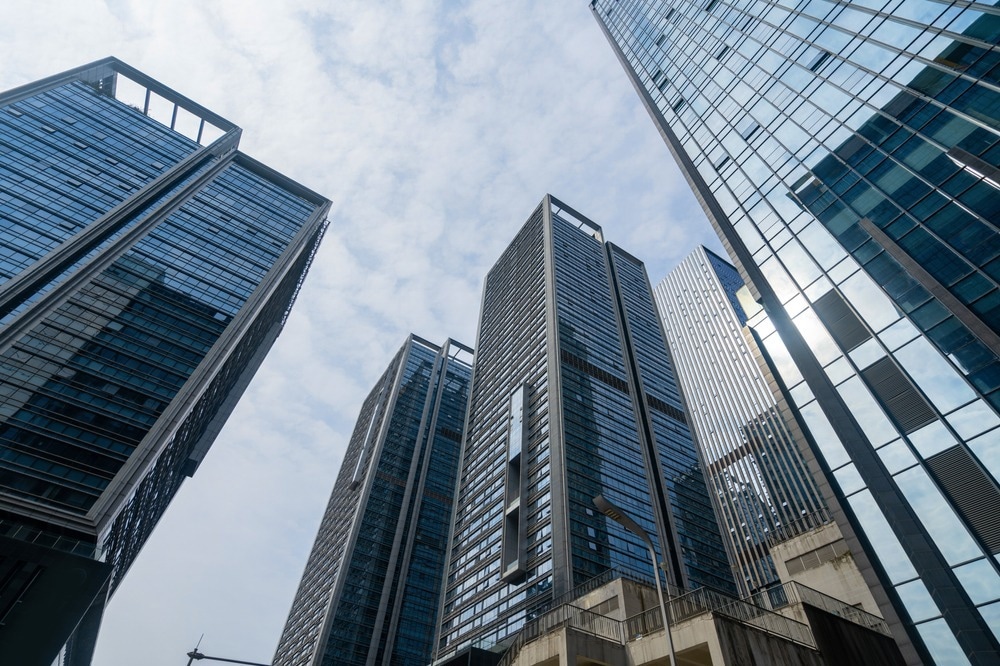Fluid viscous dampers were first developed in the 1960s by NASA engineers, but have since found numerous civil engineering applications around the world. Viscous dampers can help protect structures from strong winds, pedestrian and car traffic loads (on bridges), and earthquakes.

Image Credit: QinJin/Shutterstock.com
What Are Viscous Dampers?
Viscous dampers are now a fairly common device for dissipating supplemental energy in buildings and infrastructure such as bridges. The best way to design, place, and size these devices have been thoroughly investigated over the last few decades, and there is a large body of work detailing viscous dampers’ effects on buildings.
Large, commercial buildings are typically made of various tall towers around a low-rise podium. Sometimes, these components are constructed in the same structure, but often they are built independently of one another and married together with construction joints. Construction joints can also be used to separate buildings with irregular floor plans and sizes.
It is important to dissipate energy between separate structures in large buildings like these. This is where viscous dampers can be effective. Viscous dampers absorb energy that is input to the structure, for example by earthquakes or winds, but not energy that the structure puts onto itself (that is, the weight of building materials).
Fluid viscous dampers dissipate energy due to fluid that flows through them. The damper is composed of a piston made of stainless steel, with a steel cylinder split into two chambers and the piston head in the middle. A hydraulic fluid that can be compressed, such as silicone oil, is contained within the device, as well as an accumulator which makes the fluid circulate through the device more smoothly.
Viscous Dampers in Use
Some of the world’s tallest buildings utilize viscous dampers to mitigate risks from seismic activity. The Taipei 101, in Taipei, Taiwan, was the world’s tallest building when it was built in 2004, at 508 m. The building uses eight viscous dampers to control the motion of a tuned mass damper that sits on its roof. The damper system has already helped the building withstand earthquakes, one in March 2005 and one in May 2008. It must also resist the pressures of numerous strong typhoon winds.
In Manila, in the Philippines, the St Francis Shangri-La Towers is a 213 m tall residential development made of two towers. The St Francis Shangri-La has 32 viscous dampers installed. The global engineering company, Arup, deployed the viscous damper system at the St Francis Shangri-La according to a patented configuration.
How Effective Are Viscous Dampers?
There have been numerous studies examining the effectiveness of viscous dampers. However, these have typically focused on the devices’ impact in mitigating the risk of seismic action between two buildings that are separate to one another.
The effectiveness of viscous dampers in complex situations is much less understood. There is comparatively little research that takes into account nonlinear seismic behavior and dynamic properties of adjacent buildings.
In fact, it may even be the case that installing too many dampers or installing them in the wrong place can have adverse effects on buildings’ structural integrity under dynamic load conditions.
New Study Sheds Light on Viscous Dampers’ Effectiveness in Construction
In a study published in a 2022 edition of the journal Buildings, researchers have sought to address these knowledge gaps.
Civil engineers and architectural researchers from China’s Sichuan University and Southwest Architectural Design and Research Institute, respectively, investigated how well buildings respond to earthquakes and seismic activity if they are connected by viscous dampers.
The team looked at complex damper applications including connecting buildings at inter-story levels and connecting buildings across the same floor level. They were interested in the different dynamic properties of adjacent buildings.
The scientists applied numerical models to accurately measure these damper systems’ response to both frequent earthquakes and rarely occurring (larger) earthquakes.

Image Credit: ELEPHOTOS/Shutterstock.com
They found that, in these complex situations, viscous dampers can have a negative impact on a building’s structural integrity under dynamic loads.
This was mostly attributed to the dynamic response between buildings: when dampers were installed between buildings it sometimes led to the adjacent building taking on the dynamic energy and moving, rather than that energy being dissipated in the connecting damper.
Recommendations for Viscous Damper Use to Dissipate Seismic Energy Loads
The researchers concluded that, in general, a much more detailed engineering assessment should be required when designing and installing viscous dampers in large buildings.
They summarized their findings with three main points:
First, connecting viscous dampers can cause a coupled response in adjacent buildings, which in some cases could amplify the seismic response.
Second, they found that this coupling effect tended to be much more pronounced on higher floors. As a result, they recommend that engineers take careful consideration when connecting two buildings with dampers.
Finally, they concluded that traditional viscous damper placement is more effective for single-building seismic control.
More from AZoBuild: How Can We Engage Stakeholders in Circular Construction?
References and Further Reading
Agrawal, A.K., and M. Amjadian (2021). Innovative Bridge Design Handbook. Butterworth-Heinemann. doi.org/10.1016/C2019-0-05398-8.
Chen, P., and X. Wu (2022). Investigations on the Dynamic Response of Adjacent Buildings Connected by Viscous Dampers. Buildings. doi.org/10.3390/buildings12091480.
De Domenico, D., et al (2019). Design strategies of viscous dampers for seismic protection of building structures: A review. Soil Dynamics and Earthquake Engineering. doi.org/10.1016/j.soildyn.2018.12.024.
Infanti, S., et al (2008). Viscous Dampers for High-Rise Buildings. [Online] The 14th World Conference on Earthquake Engineering. Available at: https://www.researchgate.net/publication/248391320_VISCOUS_DAMPERS_FOR_HIGH-RISE_BUILDINGS (Accessed on 26 September 2022).
McNamara, R.J., and D.P. Taylor (2003). Fluid viscous dampers for high-rise buildings. Structural Design of Tall and Special Buildings. doi.org/10.1002/tal.218.
Viscous Dampers. [Online] Fuji Engineering. Available at: https://www.fujiengineering.com/viscous-dampers.php (Accessed on 26 September 2022).
Disclaimer: The views expressed here are those of the author expressed in their private capacity and do not necessarily represent the views of AZoM.com Limited T/A AZoNetwork the owner and operator of this website. This disclaimer forms part of the Terms and conditions of use of this website.